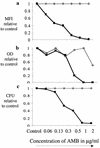Conidial viability assay for rapid susceptibility testing of Aspergillus species
- PMID: 12149322
- PMCID: PMC120618
- DOI: 10.1128/JCM.40.8.2741-2745.2002
Conidial viability assay for rapid susceptibility testing of Aspergillus species
Abstract
Antifungal susceptibility testing of filamentous fungi has become more important given the recognition of drug-resistant organisms and the availability of therapies other than amphotericin B (AMB). As current microdilution and E-test methods are limited by a 2 to 3 day incubation time required to obtain results, a more rapid method for susceptibility testing of fungi is needed. We report here a flow cytometric assay that relies on conidial metabolism of the viability dye FUN-1. Conidia are incubated in media containing increasing concentrations of AMB for 3 h, exposed to FUN-1, and then analyzed by flow cytometry. Relative susceptibility to AMB can be measured both by forward and side scatter characteristics of the conidial population and by mean fluorescence intensity (MFI) of the dye. MIC, calculated as the concentration of AMB to yield 90% reduction in MFI relative to growth controls, was determined for 27 clinical isolates Aspergillus species and correlated well with the standard (i.e., NCCLS) method. The results of these studies illustrate a method by which AMB susceptibility can be rapidly and reproducibly determined by measuring conidial viability.
Figures




References
-
- Bartizal, K., C. J. Gill, G. K. Abruzzo, A. M. Flattery, L. Kong, P. M. Scott, J. G. Smith, C. E. Leighton, A. Bouffard, J. F. Dropinski, and J. Balkovec. 1997. In vitro preclinical evaluation studies with the echinocandin antifungal MK-0991 (L-743,872). Antimicrob. Agents Chemother. 41:2326-2332. - PMC - PubMed
-
- Deere, D., J. Shen, G. Vesey, P. Bell, P. Bissinger, and D. Veal. 1998. Flow cytometry and cell sorting for yeast viability assessment and cell selection. Yeast 14:147-160. - PubMed
Publication types
MeSH terms
Substances
Grants and funding
LinkOut - more resources
Full Text Sources
Other Literature Sources
Research Materials

